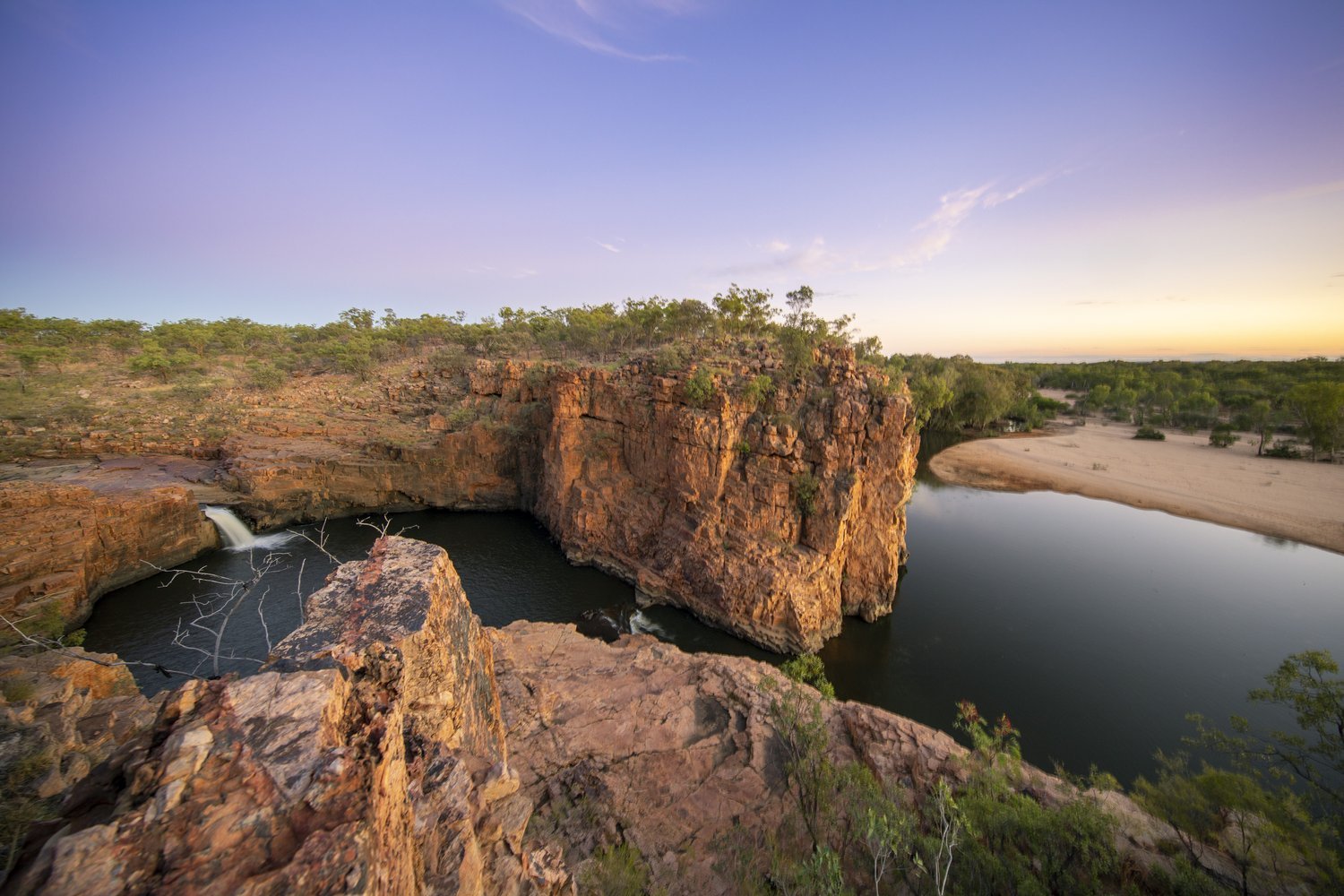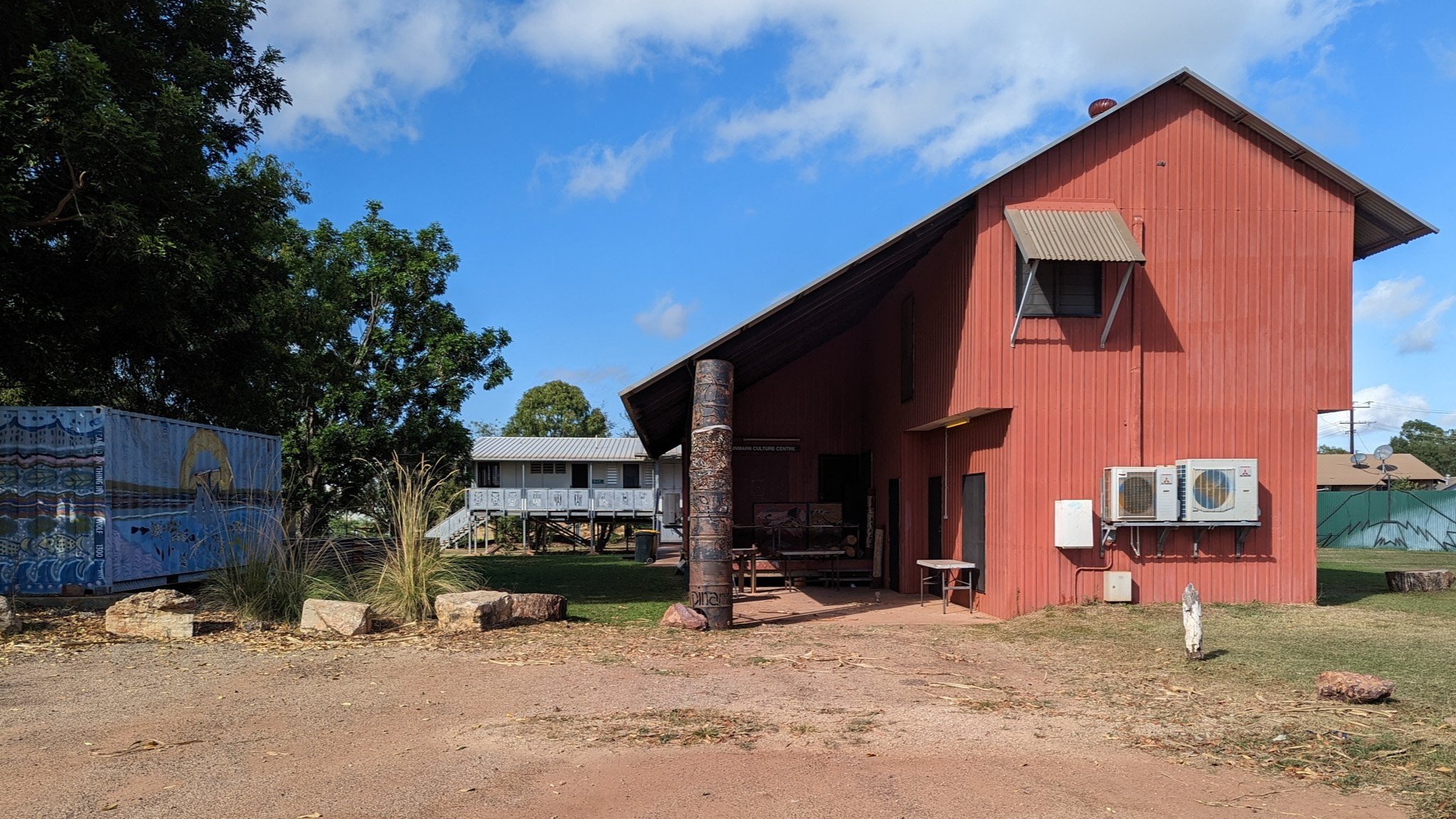
Case Study:
Djilpin Arts, Wugularr (Beswick)
Djilpin Arts during the official opening of the arts pavilion in 2016.
Image courtesy of Djilpin Arts, Photographer: Peter Eve
The community of Wugularr (also known as Beswick), was settled on the lands of the Bagala clan of the Jawoyn people. Along with the Jawoyn, it is home to people from the Rembarranga, Mayali, Dalabon, Marra, Rithurangu/Wagalak, Jingili/Mudburra and Jinang language groups, all connected by kinship and family ties from North, Central and West Arnhem Land and East as far as Numbulwar.
In 2002 acclaimed actor, musician and Murrungun, Wandarrang man, Balang Tom. E. Lewis (1958-2018) returned to the Northern Territory and founded Djilpin Arts in Wugularr to “maintain, develop and promote local art and culture.” Valuing and sustaining Indigenous Cultural knowledge systems underpins all Djilpin’s actions: doing so with a spirit that also invites visitors to walk together to experience and understand Country.
I have created a summary as I understand it but see their website to hear directly from them. From 2002 to 2017 the ‘Walking with Spirits Festival’ was an annual cultural celebration presented in partnership with the Australian Shakespeare Company. Held 15 kilometres from the community at the spectacular sacred site of Malkgulumbu (Beswick Falls), it included concerts and traditional corroboree from several Arnhem Land languages together with songs and stories told in dance, music and puppetry. As Balang stated: “The land is our church and everything in it is one – the dancers not only represent, but enter into the spirits of the animals, plants and seasons.”
In 2004 Djilpin Arts a digital media program was established, working with the young to create films about Culture and for Community. Ghunmarn Culture Centre, opened in 2007, includes a museum and retail space. It is the Keeping Place for the Blanasi Collection, called Gunwinjgu (The Company of People), a permanent showcase of culturally significant art works in the West Arnhem painting style curated by the late Elder and didgeridoo master, David Blanasi.
Djilpin artists engage with many cultural forms that include dance, art, ceremony, music and other contemporary mediums for maintaining cultural knowledge. The Bagala are Billabong people who would traditionally use red and yellow ochre but now work with acrylic on canvas. They are also known for carving – particularly spears and Mako (didgeridoo), and fibre art.
Djilpin Arts opened another gallery in Katherine in 2012 in the centre of town and subsequently relocated to the Shed in Katherine East in 2020. In the spirit of walking together and sharing culture, Djilpin offers tours to the sacred Malkgulumbu (Beswick Falls) and surrounding Country along with cultural workshops such as weaving. They have accommodation and camping facilities for visitors onsite and also host performances and cultural events.
“‘Rich in spirit, Culture is powerful medicine, bringing healing to the community and inspiration and understanding to the visitors that we welcome to walk with us’ ”
Walking with Spirits Festival 2015, celebrating the stories, spirits and culture of Melkjulumbu and its people.
Image courtesy of Djilpin Arts, Photographer: Peter Eve, Monsoon Studio

Melkulumbu (Beswick Falls), one of the most sacred and celebrated places on Wugularr country, 15kms along the Waterhouse River.
Image courtesy Djiplin Arts, Photographer: Peter Eve
I arrived into Wugularr late in the afternoon, having picked up my hire car from Katherine airport and driven the 118 km, an hour south-east. There was work taking place on the Stuart Highway and I nearly missed the turn onto a single lane sealed Central Arnhem Road. I understood the etiquette having been a passenger many times. As other cars approached, I drifted to the left, keeping the right wheels on the bitumen and the left on the dirt, coming back onto the road after we passed. It was a beautiful drive, largely straight until Barunga where it took some gentle curves. The topography was mixed, sometimes flat with trees then with rocky outcrops that gave the land definition and character.
Following a sign that said Beswick I found myself on a road full of activity. I slowed the car to a walking pace, as children and dogs scurried around enjoying play. There was lively chatter from adults and yelps of delight from the kids. My first impressions was of a green and vibrant community.
Unfortunately the tours to Melkulumbu in the featured picture, or to Bullocky Head, a culturally important boys to men ceremony area were not running on the days of my visit but I plan to return.
I visited Djilpin Arts on the 8 and 9 June 2022 staying two nights in the very special Djakanimba Pavilions. There was a couple camping who warmly welcomed me on arrival, evidently feeling at home and someone in the room adjacent with whom I shared the generous bathroom and verandah. More guests arrived the following night who were working at the Barunga Festival taking place over the weekend and marking 35 years since the “Barunga Statement”. Written on bark and presented to Prime Minister Bob Hawke in 1988 it called for Aboriginal self-management, a national system of land rights, compensation for loss of lands, respect for Aboriginal identity and the granting of full civil, economic, social and cultural rights.
The Djilpin team were also preparing for the festival where they were hosting a stall in the art market. They were carefully packing efficient display systems and works to sell; paintings, prints, fibre-art including Dragonfly that signal the dry season, spears, didgeridoos/ Mako’s and textiles with beautiful prints – I was especially fond of one with dilly bags. There was anticipation in the air. Young boys were practicing their bungul, traditional ceremonial dance, that I would see performed 2 days later at the festival alongside the Red Flag Dancers from Numbulwar. Elders and artists dropped in to coordinate and check on plans. Due to the festival, there was unusually only one young artist working while I was there carving. A Yolgnu man from Donydji, he too was also looking forward to the festival and playing footy for the Beswick Bears (who won!).
Red Flag dancers from Numbulwar, Barunga Festival 2023, celebrating 35 years since the Barunga Statement

Architecture
Djilpin Arts has created the Ghunmarn Cultural Precinct with a series of permanent buildings and temporary structures that become the stage set for festivals and cultural events. It has been built to a masterplan conceived between Insideout Architects and Djilpin Arts and developed in stages.
The Ghunmarn Culture Centre inhabits what was originally a house that was significantly rebuilt and extended after a flood of 1998. A major renovation funded by the Ian Thorpe foundation opened in 2007. The 2-storey building, painted a deep ochre red, has a strong street presence with its steep roof that shades the men’s carving space, one of the first things seen on approach. A gallery of contemporary works occupies the downstairs and the Blanasi Collection upstairs. To the rear is a large, shaded veranda on which artists, community and visitors gather.
From the veranda a ramp leads up to the arts pavilion a retail gallery, a kitchen (used by staff and artists), a camp kitchen, toilets and a laundry servicing the accommodation. This is the second stage of the project, the first was the Djakanimba Pavilions, four interconnected pavilions that work as both event hosting spaces and accommodation for visitors that opened in 2012. Again, these are prefabricated pavilions of light-weight construction, raised above the ground to the 100-year flood level. They are planned so the four rooms can operate independently or together, with a bathroom shared between two, accessed from a verandah. They all have fold down beds which can disappear into walls so the spaces can be used for other activities. The central two rooms are separated by a retractable wall, that when opened creates a large space to convene meetings, workshops events or exhibitions, or can be used as one large room for family accommodation.
Insideout Architects worked alongside the Djilpin Arts crew which included the director, manager, artists, Wugularr builders and arts workers.
1. Ghunmarn Culture Centre
2. Men’s carving space
3. Coffee Machine
4. Covered Verandah
5. Retail Gallery
6. Kitchen
7. Bathroom
8. Laundry
9. Camp Kitchen
10. Djakanimba Pavilions
11. Accommodation Units
12. Shelter
13. Camping
14. Stage
15. Shipping Container
To a first-time visitor and outsider, Djilpin felt a very strong and cohesive cultural precinct deeply connected to Country. The siting of the buildings worked with the landscape and topography and created a feeling of flow across the site and connection with the surroundings. Distances between buildings and structures felt appropriate, maintaining connection while not encroaching on the different functions. During the days of my visit, I could always find places to sit with good air movement and thermal comfort.
The pavilions are raised on stilts to mitigate flood risks which also creates a positive sense of continuous connection to the ground plane. It is easy to see who moves across the site and the activities taking place, creating social connection, and enabling oversight. The elevation provided greater air-movement within the structures. Services such as plumbing were also exposed rather than buried in the ground, likely making upkeep and maintenance simple.
The pavilions touch the ground lightly, held up on very delicate columns that effortlessly prop floor and roofs. The roofs intersect but there is breathing space between each sleeping pavilion. The stairs, with their distinctive balustrades, stretch into the landscape. The whole composition could be likened to an elegant dance.
The pavilion form and construction express modesty with subtle design flare. The sloping roofs provide good sun and rain cover and lead the eye towards the sky, and the shining stars at night when sitting on the verandah. The pavilions are very well planned, incorporating indoor and outdoor spaces. They can operate in different modes and configurations. The outer pavilions have two entrances, from the shared balcony or direct from the staircase, so they could be subdivided in the future (there is no retractable wall in place currently). All the spaces are generous in scale and volume. There is an efficiency of means within the design and construction.
A generous shared verandah links two accommodation units (yellow double door on left and orange double door on right) and a shared bathroom (yellow single door).
The bed can be folded into the wall to create an open workshop space and a wall (out of image to the right) folds back to connect the two units. Louvres can be opened for cross ventilation.
Verandah around the art pavilion with the gallery shop, and facilities for campers.
At the time of my visit artworks and merchandise was being packed to take to a stall at Barunga Festival which limited the photographs I could take of the gallery shop. It was a very pleasant space to be in with tree canopies and sky in view through high windows that bring light in and let breezes pass through.
Sitting on this verandah (left), at this long table was one of my favourite places to be. There was a cool breeze and the space fluctuated constantly with life and energy throughout the day. A place for a yarn, to make, to rest; Elders, artists, community, visitors. A quality coffee was served from a machine that sat to the right of the image. The low gentle sloping roof gave a feeling of protection and framed the surrounding landscape. There were views across the precinct – to the stage in one direction, the arts and accommodation pavilions in the other. I wandered over and stood on the stage looking back imagining what it would have been liked filled with people, music and dance – I could sense the joy.
Children played, running and finding delight everywhere; ramps, stairs, stages and grassy slopes. When exhaustion hit, they would sit watching devices or draw, finding peace too, on the verandahs.













